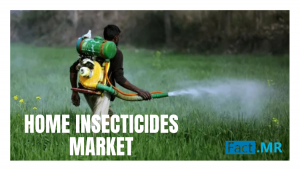Home Insecticides Market Set to Surge to USD 35.05 Billion by 2035, Driven by Urbanization and Health Awareness
Home Insecticides Market Analysis, By Form, By Composition, By Distribution Channel, By Application, and Region - Market Insights 2025 to 2035
MD, UNITED STATES, August 8, 2025 /EINPresswire.com/ -- The global home insecticides market is expected to reach USD 35,055 million by 2035, up from USD 16,822 million in 2024. During the forecast period (2025- 2035), the industry is projected to register at a CAGR of 7.0%. according to a comprehensive report by Fact.MR. Fueled by rising awareness of insect-borne diseases, rapid urbanization, and innovative eco-friendly solutions, the market is poised to transform household pest control worldwide.Browse for A Report: https://www.factmr.com/report/127/home-insecticides-market
Market Dynamics: Health, Hygiene, and Innovation at the Core:
The home insecticides market is being propelled by heightened consumer awareness of diseases like dengue, malaria, and chikungunya, particularly in tropical regions. Urban expansion and poor sanitation, including stagnant water, exacerbate pest outbreaks, driving demand for fast-acting, user-friendly products like sprays, coils, and plug-in vaporizers. Fact.MR’s analysis highlights that sprays hold a dominant 28% market share in 2025 due to their ease of use and immediate efficacy, with a projected CAGR of 6.2%. Aerosols, however, are expected to outpace them with a 7.5% CAGR, reflecting consumer preference for quick, targeted solutions.
Rising disposable incomes in developing nations, coupled with growing hygiene concerns, are boosting spending on health-related home care products. Additionally, seasonal spikes during monsoons and government-led public health campaigns are further accelerating market growth. Innovations in non-toxic, eco-friendly formulations, such as neem, citronella, and eucalyptus-based products, are resonating with health-conscious households, particularly those with children and pets.
Regional Insights: Asia Pacific Leads, U.S. and India Accelerate:
-Asia Pacific dominates the global home insecticides market, with India and China leading due to tropical climates and high prevalence of mosquito-borne diseases. India’s market is projected to grow at a robust 7.8% CAGR, driven by rising temperatures, extended monsoons, and increasing middle-class expenditure. Electric mosquito bats, vaporizer machines, and gel-based cockroach baits are gaining traction, supported by government initiatives like Swachh Bharat and the National Health Mission. Mobile-first shopping trends and innovations like smart vaporizers are further reshaping India’s market.
-In North America, the U.S. leads with a 6.8% CAGR, driven by consumer demand for plant-based, fragrance-free, and zero-DEET products. The EPA’s stringent regulations are pushing manufacturers like Bayer AG and S.C. Johnson & Son, Inc. to invest in botanically based ingredients like pyrethrin and essential oil blends. Smart dispensers and pest-tracking apps are gaining popularity in urban areas, while e-commerce and direct-to-consumer models expand access.
-Latin America, particularly Brazil, is seeing growth due to periodic outbreaks of Zika and dengue, supported by government health initiatives. The Middle East & Africa is an emerging market, with urbanization and public health concerns driving demand, though price sensitivity remains a challenge.
Category Highlights: Sprays and Synthetic Formulations Lead:
-By Form: Sprays dominate due to their convenience and rapid action, making them ideal for spot treatments in urban homes. Aerosols and electric vaporizers are also gaining traction, particularly in Asia Pacific.
-By Composition: Synthetic formulations, including pyrethroids and organophosphates, lead the market for their broad-spectrum efficacy and residual protection. However, regulatory scrutiny in regions like the EU and California is driving a shift toward low-toxicity variants and natural alternatives like citronella and neem oil-based products.
Challenges and Opportunities:
The market faces challenges from regulatory pressures on chemical formulations, with restrictions on aerosols and pesticides limiting innovation in some regions. Consumer aversion to toxic ingredients, especially in households with children and pets, is pushing manufacturers toward natural and herbal solutions, which require significant R&D investment. Seasonality also impacts demand, with peaks in warmer months and declines in winter.
However, opportunities abound. The shift toward sustainable, biodegradable packaging and child-safe bait systems is creating new avenues for growth. Smart insecticide delivery systems, such as AI-enabled dispensers, are emerging as differentiators, particularly in urban markets. Companies like Godrej Consumer Products Ltd., which launched Renofluthrin in its Goodknight Flash vaporizer in July 2024, are setting benchmarks for speed and efficacy.
Competitive Landscape: Innovation and Digital Transformation:
The home insecticides market is highly competitive, with key players like Shogun Organics Ltd., Bayer AG, FMC, and Godrej Consumer Products Ltd. driving innovation. Companies are focusing on non-toxic, eco-friendly products to meet consumer demand and comply with regulations. Digital transformation is reshaping the landscape, with e-commerce platforms enhancing product visibility and consumer engagement through subscriptions and feedback loops. Pricing remains a critical factor in price-sensitive markets like Asia and Latin America, where value-driven offerings dominate.
Recent developments underscore the industry’s dynamism. In April 2025, the U.S. EPA’s Insecticide Strategy under the Endangered Species Act introduced reduced buffer zones and runoff protections, balancing pest control with environmental safety. Meanwhile, brands like Aristo Biotech and Life Science Pvt. Ltd. and AIMCO Pesticides Limited are investing in localized formulations to cater to regional preferences.
Want a Sample Before Buying? Download Free Sample: https://www.factmr.com/connectus/sample?flag=S&rep_id=127
Future Outlook: Smarter, Safer, Sustainable:
The home insecticides market is evolving into a critical component of global health and hygiene. Innovations like biodegradable packaging, AI-enabled dispensers, and botanical formulations are redefining pest control. As urbanization and climate change intensify pest challenges, the industry is set to deliver smarter, safer, and more sustainable solutions.
Explore More Related Studies Published by Fact.MR Research:
The global Big Bag Discharge Station market is projected to increase from USD 1,334.5 Million in 2025 to USD 2,215.6 Million by 2035, with a CAGR of 5.2% during the forecast period.
The global Yogurt Cup market is projected to increase from USD 9,345.5 Million in 2025 to USD 14,374.9 Million by 2035, with a CAGR of 4.4% during the forecast period.
About Fact.MR
We are a trusted research partner of 80% of Fortune 1000 companies across the globe. We are consistently growing in the field of market research with more than 1000 reports published every year. The dedicated team of 400-plus analysts and consultants is committed to achieving the utmost level of our client’s satisfaction.
Contact:
11140 Rockville Pike
Suite 400
Rockville, MD 20852
United States
Tel: +1 (628) 251-1583
Sales Team: sales@factmr.com
Follow Us: LinkedIn | Twitter | Blog
S. N. Jha
Fact.MR
+ +1 628-251-1583
email us here
Legal Disclaimer:
EIN Presswire provides this news content "as is" without warranty of any kind. We do not accept any responsibility or liability for the accuracy, content, images, videos, licenses, completeness, legality, or reliability of the information contained in this article. If you have any complaints or copyright issues related to this article, kindly contact the author above.
35th Annual Hong Kong Dragon Boat Festival in New York Day 2 - Sunday, August 10, 2025
RockStar IMPACT 2025 Set to Take Over Los Angeles
Your Choice Plumbers Drives into the Future with a New Fleet of Ford Transit Custom Vans
Więcej ważnych informacji
 Jedynka Newserii
Jedynka Newserii

 Jedynka Newserii
Jedynka Newserii

Handel

Mercosur to tylko wierzchołek góry lodowej. UE ma ponad 40 umów handlowych, które mogą destabilizować rynek rolny
Umowa handlowa między UE a krajami Mercosur może znacząco zaburzyć konkurencję na rynku rolnym i osłabić pozycję unijnych, w tym polskich, producentów – ostrzegają rolnicy i producenci żywności. Umowie sprzeciwia się część krajów unijnych, które domagają się klauzuli ochronnych oraz limitów importowych. – Problemem jest jednak nie tylko ta konkretna umowa. Chodzi o cały system wolnego handlu, który się kumuluje z dziesiątek innych porozumień – podkreśla Andrzej Gantner, wiceprezes Polskiej Federacji Producentów Żywności.
Firma
Dzięki zdalnej weryfikacji tożsamości z wykorzystaniem AI firmy zminimalizowały liczbę oszustw. Rozwiązania wykorzystuje głównie sektor finansowy

Z najnowszych danych Eurostatu wynika, że w 2024 roku 5,9 proc. polskich firm korzystało z rozwiązań z zakresu sztucznej inteligencji. W 2023 roku był to odsetek na poziomie 3,67 proc. Wciąż jednak jest to wynik poniżej średniej unijnej, która wyniosła 13,48 proc. Jednym z obszarów, który cieszy się coraz większym zainteresowaniem wśród przedsiębiorców, jest weryfikacja tożsamości przez AI, zwłaszcza w takich branżach jak bankowość, ubezpieczenia czy turystyka. Jej zastosowanie ma na celu głównie przeciwdziałać oszustwom i spełniać wymogi regulacyjne.
Prawo
Daniel Obajtek: Własne wydobycie i operacyjne magazyny to filary bezpieczeństwa. Zgoda na magazyny gazu poza krajem to rezygnacja z suwerenności energetycznej

Były prezes Orlenu ostrzega przed zmianami w ustawie o zapasach ropy naftowej, produktów naftowych i gazu ziemnego. Jego zdaniem przygotowana przez rząd nowelizacja tzw. ustawy magazynowej i ujednolicanie unijnej polityki energetycznej to zagrożenie dla bezpieczeństwa energetycznego Polski. W jego opinii tylko silna spółka narodowa, własne wydobycie, krajowe magazyny i zbilansowany miks energetyczny zapewnią Polsce bezpieczeństwo i konkurencyjność.
Partner serwisu
Szkolenia

Akademia Newserii
Akademia Newserii to projekt, w ramach którego najlepsi polscy dziennikarze biznesowi, giełdowi oraz lifestylowi, a także szkoleniowcy z wieloletnim doświadczeniem dzielą się swoją wiedzą nt. pracy z mediami.





![Nestlé w Polsce podsumowuje wpływ na krajową gospodarkę. Firma wygenerowała 0,6 proc. polskiego PKB [DEPESZA]](https://www.newseria.pl/files/1097841585/fabryka-nesquik_1,w_85,r_png,_small.png)



.gif)

 |
| |
| |
|